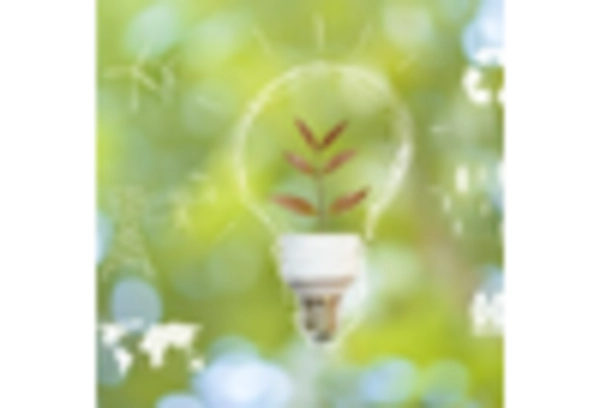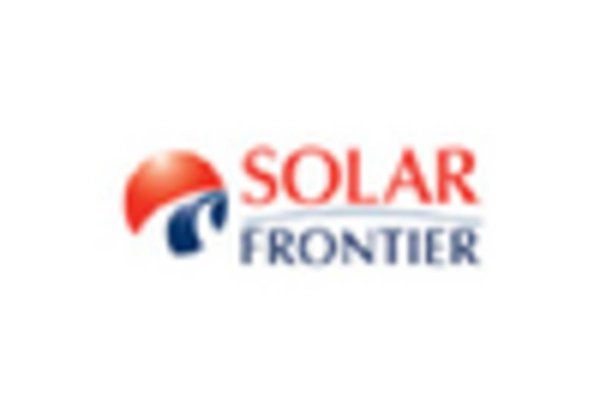Rising Energy Costs and Demand for Efficiency
The Thin Film Photovoltaic Market is also driven by rising energy costs and an increasing demand for energy efficiency. As traditional energy prices continue to escalate, consumers and businesses are seeking alternative energy solutions that offer long-term savings. Thin film photovoltaics, known for their lightweight and flexible characteristics, present an attractive option for various applications, including building-integrated photovoltaics. The ability to install these systems in diverse environments enhances their appeal, potentially leading to a broader market penetration. Moreover, the Thin Film Photovoltaic Market is likely to benefit from the growing awareness of energy conservation and sustainability among consumers. This shift in mindset is expected to further stimulate demand for thin film technologies, as they provide a viable solution to mitigate energy costs while promoting environmental responsibility.
Increasing Adoption of Renewable Energy Policies
The Thin Film Photovoltaic Market is significantly influenced by the increasing adoption of renewable energy policies across various regions. Governments are implementing incentives and subsidies to promote solar energy, which is likely to drive demand for thin film technologies. For example, feed-in tariffs and tax credits have been established in numerous countries to encourage the installation of solar systems. This regulatory support is expected to create a favorable environment for the growth of the Thin Film Photovoltaic Market. Additionally, international agreements aimed at reducing carbon emissions are further propelling the shift towards renewable energy sources. As a result, the market for thin film photovoltaics is anticipated to expand, as stakeholders seek to comply with these evolving regulations and capitalize on the benefits of sustainable energy solutions.
Diverse Application Areas of Thin Film Technologies
The Thin Film Photovoltaic Market is characterized by its diverse application areas, which contribute to its growth potential. Thin film technologies can be utilized in various sectors, including residential, commercial, and industrial applications. Their lightweight and flexible nature allows for integration into unconventional surfaces, such as building facades and vehicles. This versatility is likely to attract a wide range of customers, from homeowners to large corporations. Additionally, the increasing trend of off-grid solar solutions is expected to further expand the market for thin film photovoltaics. As more consumers seek energy independence, the adaptability of thin film technologies positions them as a favorable choice. Consequently, the Thin Film Photovoltaic Market is anticipated to flourish as it caters to the evolving needs of various sectors, capitalizing on the growing demand for innovative energy solutions.
Environmental Concerns and Sustainability Initiatives
The Thin Film Photovoltaic Market is increasingly shaped by environmental concerns and sustainability initiatives. As awareness of climate change and environmental degradation grows, there is a heightened demand for clean energy solutions. Thin film photovoltaics, which typically have a lower carbon footprint during production compared to traditional solar technologies, are well-positioned to meet this demand. Furthermore, many manufacturers are adopting sustainable practices in their production processes, which enhances the appeal of thin film technologies. This alignment with sustainability goals is likely to resonate with environmentally conscious consumers and businesses alike. As a result, the Thin Film Photovoltaic Market is expected to benefit from this trend, as stakeholders prioritize eco-friendly solutions in their energy strategies.
Technological Innovations in Thin Film Photovoltaic Market
The Thin Film Photovoltaic Market is experiencing a surge in technological innovations that enhance efficiency and reduce production costs. Recent advancements in materials, such as cadmium telluride and amorphous silicon, have led to improved energy conversion rates. For instance, the efficiency of cadmium telluride modules has reached approximately 22%, making them competitive with traditional silicon-based solar cells. Furthermore, the integration of nanotechnology and advanced manufacturing techniques is likely to streamline production processes, thereby lowering costs. This trend not only boosts the economic viability of thin film technologies but also positions them favorably against other renewable energy sources. As a result, the Thin Film Photovoltaic Market is poised for substantial growth, driven by these innovations that promise to enhance performance and affordability.


















Leave a Comment